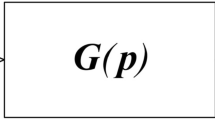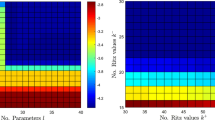Abstract
Topology optimization problems with natural frequency or structural stability criteria often utilize objective or constraint functions computed from the eigenvalues of a generalized eigenvalue problem. However, design formulations involving the eigenvectors are not common, due to both the difficulties that occur in the presence of repeated eigenvalues and the computational cost of computing eigenvector derivatives. To address the formulation problem, a smoothly differentiable function is proposed that is computed based on the eigenvalues and eigenvectors of a generalized eigenvalue problem. This eigenvector aggregate is constructed to approximate a homogeneous quadratic function of the eigenvector associated with the smallest eigenvalue. To address the computational cost, a technique is proposed to compute high accuracy approximations of the derivative of the eigenvector aggregate by solving a sequence of related linear systems with a constrained Krylov method that incorporates orthogonal projection. The proposed eigenvector aggregate can be used to impose displacement and stress constraints on the eigenvectors. Results are shown for a tube and 2D topology optimization problems, each with bimodal lowest eigenvalue.












Similar content being viewed by others
References
Akgun MA (1994) New family of modal methods for calculating eigenvector derivatives. AIAA J 32(2):379–386. https://doi.org/10.2514/3.11995
Andrew AL, Tan RCE (1998) Computation of derivatives of repeated eigenvalues and the corresponding eigenvectors of symmetric matrix pencils. SIAM J Matrix Anal Appl 20(1):78–100. https://doi.org/10.1137/S0895479896304332
Andrew AL, Chu K-WE, Lancaster P (1993) Derivatives of eigenvalues and eigenvectors of matrix functions. SIAM J Matrix Anal Appl 14(4):903–926. https://doi.org/10.1137/0614061
Bernard ML, Bronowicki AJ (1994) Modal expansion method for eigensensitivity with repeated roots. AIAA J 32(7):1500–1506. https://doi.org/10.1016/S0045-7949(96)00207-6
Bratus A, Seiranian A (1983) Bimodal solutions in eigenvalue optimization problems. J Appl Math Mech 47(4):451–457. https://doi.org/10.1016/0021-8928(83)90081-3
Chen X, Qi H, Qi L, Teo K-L (2004) Smooth convex approximation to the maximum eigenvalue function. J Glob Optim 30(2):253–270. https://doi.org/10.1007/s10898-004-8271-2
Dailey RL (1989) Eigenvector derivatives with repeated eigenvalues. AIAA J 27(4):486–491. https://doi.org/10.2514/3.10137
Dalklint A, Wallin M, Tortorelli DA (2020) Eigenfrequency constrained topology optimization of finite strain hyperelastic structures. Struct Multidisc Optim 61:2577–2594. https://doi.org/10.1007/s00158-020-02557-9
Dalklint A, Wallin M, Tortorelli DA (2021) Structural stability and artificial buckling modes in topology optimization. Struct Multidisc Optim 64(4):1751–1763. https://doi.org/10.1007/s00158-021-03012-z
Dalklint A, Wallin M, Bertoldi K, Tortorelli D (2022) Tunable phononic bandgap materials designed via topology optimization. J Mech Phys Solids 163:104849. https://doi.org/10.1016/j.jmps.2022.104849
Du J, Olhoff N (2007) Topological design of freely vibrating continuum structures for maximum values of simple and multiple eigenfrequencies and frequency gaps. Struct Multidisc Optim 34(2):91–110. https://doi.org/10.1007/s00158-007-0101-y
Ferrari F, Sigmund O (2019) Revisiting topology optimization with buckling constraints. Struct Multidisc Optim 59(5):1401–1415. https://doi.org/10.1007/s00158-019-02253-3
Ferrari F, Lazarov BS, Sigmund O (2018) Eigenvalue topology optimization via efficient multilevel solution of the frequency response. Int J Numer Methods Eng 115(7):872–892. https://doi.org/10.1002/nme.5829
Fox R, Kapoor M (1968) Rates of change of eigenvalues and eigenvectors. AIAA J 6(12):2426–2429. https://doi.org/10.2514/3.5008
Gao B, Pavel L (2018) On the properties of the softmax function with application in game theory and reinforcement learning. https://doi.org/10.48550/ar**v.1704.00805
Giles MB (2008) Collected matrix derivative results for forward and reverse mode algorithmic differentiation. In: Bischof CH, Bücker HM, Hovland P, Naumann U, Utke J (eds) Advances in Automatic Differentiation. Springer, Berlin, pp 35–44. ISBN 978-3-540-68942-3. https://doi.org/10.1007/978-3-540-68942-3_4
Gravesen J, Evgrafov A, Nguyen DM (2011) On the sensitivities of multiple eigenvalues. Struct Multidisc Optim 44(4):583–587. https://doi.org/10.1007/s00158-011-0644-9
Haug EJ, Rousselet B (1980) Design sensitivity analysis in structural mechanics. II. Eigenvalue variations. J Struct Mech 8(2):161–186. https://doi.org/10.1080/03601218008907358
Haug EJ, Choi KK, Komkov V (1986) Design sensitivity analysis of structural systems. 1. https://www.osti.gov/biblio/5759172
He S, Jonsson E, Martins JR (2022) Derivatives for eigenvalues and eigenvectors via analytic reverse algorithmic differentiation. AIAA J 60(4):2654–2667. https://doi.org/10.2514/1.J060726
He S, Shi Y, Jonsson E, Martins JR (2023) Eigenvalue problem derivatives computation for a complex matrix using the adjoint method. Mech Syst Signal Process 185:109717. https://doi.org/10.1016/j.ymssp.2022.109717
Huang X, Zuo Z, **e Y (2010) Evolutionary topological optimization of vibrating continuum structures for natural frequencies. Comput Struct 88(5–6):357–364. https://doi.org/10.1016/j.compstruc.2009.11.011
Jensen J, Sigmund O (2011) Topology optimization for nano-photonics. Laser Photonics Rev 5(2):308–321. https://doi.org/10.1002/lpor.201000014
Juang J-N, Ghaemmaghami P, Lim KB (1989) Eigenvalue and eigenvector derivatives of a nondefective matrix. J Guid Control Dyn 12(4):480–486. https://doi.org/10.2514/3.20435
Kennedy G, Fu Y (2021) Topology optimization benchmark problems for assessing the performance of optimization algorithms. In: AIAA Scitech 2021 Forum, January 2021. https://doi.org/10.2514/6.2021-1357. https://arc.aiaa.org/doi/abs/10.2514/6.2021-1357. AIAA 2021-1357
Kennedy G, Fu Y (2022) Topology optimization with natural frequency constraints using a quadratic approximation of a spectral aggregate. In: AIAA SCITECH 2022 Forum, January 2022. https://doi.org/10.2514/6.2022-2244. https://arc.aiaa.org/doi/abs/10.2514/6.2022-2244. AIAA 2022-2244
Kennedy GJ, Hicken JE (2015) Improved constraint-aggregation methods. Comput Methods Appl Mech Eng 289:332–354. https://doi.org/10.1016/j.cma.2015.02.017
Kim TS, Kim YY (2000) Mac-based mode-tracking in structural topology optimization. Comput Struct 74(3):375–383. https://doi.org/10.1016/S0045-7949(99)00056-5
Kim TS, Kim JE, Kim YY (2004) Parallelized structural topology optimization for eigenvalue problems. Int J Solids Struct 41(9):2623–2641. https://doi.org/10.1016/j.ijsolstr.2003.11.027
Krog LA, Olhoff N (1999) Optimum topology and reinforcement design of disk and plate structures with multiple stiffness and eigenfrequency objectives. Comput Struct 72(4):535–563. https://doi.org/10.1016/S0045-7949(98)00326-5
Lancaster P (1964) On eigenvalues of matrices dependent on a parameter. Numer Math 6(1):377–387
Le C, Norato J, Bruns T, Ha C, Tortorelli D (2010) Stress-based topology optimization for continua. Struct Multidisc Optim 41(4):605–620. https://doi.org/10.1007/s00158-009-0440-y
Leader MK, Chin TW, Kennedy GJ (2019) High-resolution topology optimization with stress and natural frequency constraints. AIAA J 57(8):3562–3578. https://doi.org/10.2514/1.J057777
Lee TH (2007) Adjoint method for design sensitivity analysis of multiple eigenvalues and associated eigenvectors. AIAA J 45(8):1998–2004. https://doi.org/10.2514/1.25347
Lee I-W, Jung G-H (1997a) An efficient algebraic method for the computation of natural frequency and mode shape sensitivities—Part I. Distinct natural frequencies. Comput Struct 62(3):429–435. https://doi.org/10.1016/S0045-7949(96)00206-4
Lee I-W, Jung G-H (1997b) An efficient algebraic method for the computation of natural frequency and mode shape sensitivities–Part II. Multiple natural frequencies. Comput Struct 62(3):437–443. https://doi.org/10.1016/S0045-7949(96)00207-6
Lim K, Junkins J, Wang B (1987) Re-examination of eigenvector derivatives. J Guid Control Dyn 10(6):581–587. https://doi.org/10.2514/3.20259
Lin R, Mottershead J, Ng TY (2020) A state-of-the-art review on theory and engineering applications of eigenvalue and eigenvector derivatives. Mech Syst Signal Process 138:106536. https://doi.org/10.1016/j.ymssp.2019.106536
Mills-Curran WC (1988) Calculation of eigenvector derivatives for structures with repeated eigenvalues. AIAA J 26(7):867–871. https://doi.org/10.2514/3.9980
Nelson RB (1976) Simplified calculation of eigenvector derivatives. AIAA J 14(9):1201–1205. https://doi.org/10.2514/3.7211
Ojalvo IU (1988) Efficient computation of modal sensitivities for systems with repeated frequencies. AIAA J 26(3):361–366. https://doi.org/10.2514/3.9897
Olhoff N, Rasmussen SH (1977) On single and bimodal optimum buckling loads of clamped columns. Int J Solids Struct 13(7):605–614. https://doi.org/10.1016/0020-7683(77)90043-9
Rudisill CS, Chu Y-Y (1975) Numerical methods for evaluating the derivatives of eigenvalues and eigenvectors. AIAA J 13(6):834–837. https://doi.org/10.2514/3.60449
Ruiz D, Bellido J, Donoso A (2017) Eigenvector sensitivity when tracking modes with repeated eigenvalues. Comput Methods Appl Mech Eng 326:338–357. https://doi.org/10.1016/j.cma.2017.07.031
Saad Y (2003) Iterative methods for sparse linear systems. Society for Industrial and Applied Mathematics, 2nd edn. https://doi.org/10.1137/1.9780898718003
Seyranian AP, Lund E, Olhoff N (1994) Multiple eigenvalues in structural optimization problems. Struct Optim 8:207–227. https://doi.org/10.1007/BF01742705
Svanberg K (1987) The method of moving asymptotes—a new method for structural optimization. Int J Numer Methods Eng 24(2):359–373. https://doi.org/10.1002/nme.1620240207
Tadjbakhsh I, Keller JB (1962) Strongest columns and isoperimetric inequalities for eigenvalues. J Appl Mech 29(1):159–164, 03. https://doi.org/10.1115/1.3636448
Thompson J, Hunt C (1974) Dangers of structural optimization. Eng Optim 1(2):99–110. https://doi.org/10.1080/03052157408960580
Torii A, Faria JRd (2017) Structural optimization considering smallest magnitude eigenvalues: a smooth approximation. J Braz Soc Mech Sci Eng 39(5):1745–1754. https://doi.org/10.1007/s40430-016-0583-x
Wang B (1991) Improved approximate methods for computing eigenvector derivatives in structural dynamics. AIAA J 29(6):1018–1020. https://doi.org/10.2514/3.59945
Xue L, Wen G, Wang H, Liu J (2022) Eigenvectors-guided topology optimization to control the mode shape and suppress the vibration of the multi-material plate. Comput Methods Appl Mech Eng 391:114560. https://doi.org/10.1016/j.cma.2021.114560
Acknowledgements
This research was supported in part through research cyberinfrastructure resources and services provided by the Partnership for an Advanced Computing Environment (PACE) at the Georgia Institute of Technology, Atlanta, Georgia, USA.
Author information
Authors and Affiliations
Corresponding author
Ethics declarations
Conflict of interest
The authors declare that they have no conflict of interest.
Replication of results
The results for this paper were generated with Python code that is publicly available on GitHub: https://github.com/smdogroup/eigenvector-aggregate.git.
Additional information
Responsible Editor: Makoto Ohsaki
Publisher's Note
Springer Nature remains neutral with regard to jurisdictional claims in published maps and institutional affiliations.
Appendices
Appendix 1
Here, we show that
Since \(\eta = \text {diag}\{\eta _{1}, \eta _{2}, \ldots , \eta _{n}\}\), combined with the definition of \(\eta _i\) in (11), we have
where \(\exp (\cdot )\) denotes the matrix exponential. Therefore,
Using the definition of the matrix exponential, the numerator for (56) can be expressed as
Using this relationship and the property \(Q Q^{T} = B^{-1}\), (57) can be rewritten as
Appendix 2
In this appendix, we show that
The derivative of the matrix exponential taking the generic argument X with respect to a design parameter is
Therefore, the derivative of \(\Phi\) defined in (18) can be written as
Powers of the product \(AB^{-1}\) can be expanded using the eigenvalues and eigenvectors as
Combining (62) and (63), the matrix product in the series can be simplified as follows:
As a result, the derivative of \(\Phi\) is
Using this result (64), we can express the ratio appearing in (60) as
To further simplify the above equation (65), we introduce the following Hadamard product with the matrix E, whose components are derived in Appendix 1, along with the substitution \(X = Q^{T}D Q\), such that
With this definition, equation (65) can be rewritten as
The second part of the ratio appearing in (60) can be expressed using (67) by making the substitution \(D = B = (Q Q^{T})^{-1} = Q^{-T} Q^{-1}\) resulting in
Combining (67) and (68) gives the desired result (60).
Appendix 3
In this appendix, we show that
From (66), the components of the matrix E can be expressed as the double series
We use the following property of the infinite double series
Furthermore, since the denominator for (70) \({\text{tr}}(\Phi ) = {\text{tr}}(\exp (-\rho \Lambda )) = \sum _{i=1}^{n} e^{-\rho \lambda _{i}}\), we can combine it with \(\eta _i\) defined in (11) to obtain the result shown in (69).
Rights and permissions
Springer Nature or its licensor (e.g. a society or other partner) holds exclusive rights to this article under a publishing agreement with the author(s) or other rightsholder(s); author self-archiving of the accepted manuscript version of this article is solely governed by the terms of such publishing agreement and applicable law.
About this article
Cite this article
Li, B., Fu, Y. & Kennedy, G.J. Topology optimization using an eigenvector aggregate. Struct Multidisc Optim 66, 221 (2023). https://doi.org/10.1007/s00158-023-03674-x
Received:
Revised:
Accepted:
Published:
DOI: https://doi.org/10.1007/s00158-023-03674-x




